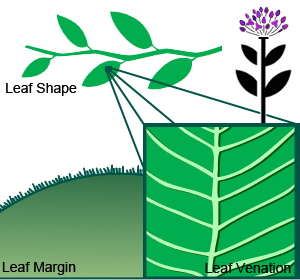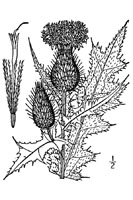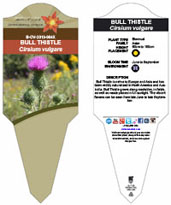Bull Thistle is a species of thistle in the genus Cirsium. The word 'Cirsium' derives from the Greek word 'kirsos' meaning 'swollen vein'. Cirsium is a genus of perennial and biennial flowering plants in the aster family that are more accurately known as Plume thistles. Native throughout most of Europe, western Asia, and northwestern Africa; Bull Thistle has become naturalized in many parts of North America and Australia and are classified as an invasive weed in some areas. The bull thistle is the national flower of Scotland and is also referred to as 'Scotch Thistle'
Bull Thistle has been traditionally used as food in rural areas of Southern Europe. The roots, leaves, stems, and flowers are used in ethnic cooking and oil can be extracted from the seeds of the plant. A fibre from the plant can be used to make a tan coloured paper.
Within the realm of naturopathic medicine and folklore, bull thistle roots have been used as a poultice to treat sore jaws. A hot infusion of the whole plant has been used as a herbal steam for treating rheumatic joints. A decoction of the whole plant has been used both internally and externally to treat bleeding piles. The seed down from the plant was used historically as tinder due to the fact that it can easily be lit from a flint spark.
Please note that MIROFOSS does not suggest in any way that plants should be used in place of proper medical and psychological care. This information is provided here as a reference only.
Bull Thistle is considered editable. The stems can be peeled and then steamed or boiled. The tap roots can be eaten raw or cooked, but only on young thistles that have not flowered yet.
Bull Thistle is known for an effusive vibrant purple flower head. The rounded cluster flowers are at the end of the branches. The flowers are hermaphrodite (have both male and female organs) and are pollinated by Bees, flies, lepidoptera, beetles, as well as self pollination. Bull Thistle has erect stems and prickly leaves, with a characteristic enlarged base of the flower which is commonly spiny. The leaves are alternate, and some species can be slightly hairy. Bull Thistle can spread by seed, and also by rhizomes below the surface. The seed has tufts of tiny hair, or pappus, which can carry them far by wind. Bull Thistle is used as a food plant by the larvae of some Lepidoptera species and the seeds are attractive to small finches such as the American Goldfinch.
| Plant Height |
60cm to 180cm |
| Habitat |
Roadsides, Pastures, and Waste Places |
| Leaves |
long, coarse, spiny leaves 7cm to 15cm long |
 |
| Leaf Margin |
Ciliate |
| Leaf Venation |
Pinnately lobed |
| Stems |
slender tall spiny stem |
| Flowering Season |
June to September |
| Flower Type |
Rounded clusters of ray less flowers |
| Flower Colour |
violet, vary rarely white |
| Pollination |
Bees, flies, lepidoptera, beetles, self |
| Flower Gender |
Flowers are hermaphrodite and the plants are self-fertile |
| Fruit |
Small silky tufts carried by wind |
| USDA Zone |
10B (4.4°C to 1.1°C) cold weather limit |
The following health hazards should be noted when handling bull thistle:
 |
SHARP HAZARD
Thistles contain small sharp thorns which can be painful if incorrectly handled.
|
 |
-Click here- or on the thumbnail image to see an artist rendering, from The United States Department of Agriculture, of bull thistle. (This image will open in a new browser tab) |
 |
-Click here- or on the thumbnail image to see a magnified view, from The United States Department of Agriculture, of the seeds created by the bull thistle for propagation. (This image will open in a new browser tab) |
Bull Thistle can be referenced in certain current and historical texts under the following three names:
Bull Thistle can be translated into the following select languages:
| Arabic |
الشوك الثور |
Bulgarian |
Bull трън |
Chinese (Sim) |
公牛蓟 |
| Croatian |
Bull čičak |
Czech |
Bull bodlák |
Danish |
Bull tidsel |
| Dutch |
Bull distel |
Esperanto |
taŭro prunelon |
Estonian |
kuldvits |
| Finnish |
Bull ohdake |
French |
Chardon de Bull |
German |
Bull ohakas |
| Greek |
γαϊδουράγκαθο Bull |
Hebrew |
גדילן בול |
Hungarian |
Bull bogáncs |
| Italian |
cardo Bull |
Japanese |
ブルアザミ |
Korean |
불 엉겅퀴 |
| Low Saxon |
|
Lithuanian |
Bull Dagys |
Norwegian |
Bull tistel |
| Persian |
طلا |
Polish |
oset Bull |
Portuguese |
cardo de Bull |
| Romanian |
ciulin taur |
Russian |
Bull чертополох |
Slovak |
bull bodliak |
| Spanish |
cardo Bull |
Swedish |
Bull tistel |
Tagalog |
Bull tistle |
| Turkish |
boğa dikeni |
Ukrainian |
Bull чортополох |
Vietnamese |
cây kế Bull |
| The information provided in this conservation assessment has been provided by the Natureserve Database in conjuction with various federal, provincial, state, county, district, regional, and municipal governments as well as public and private conservation authorities. Information in this section is accurate from the last time this article was updated. |
 |
Bull Thistle has no conservation status as it is considered an exotic and or invasive species in North America. |
 |
The MIROFOSS database offers free printable garden tags for personal and non-profit use. These tags can be used to properly identify plant samples in a garden. Click on the tags shown on the the screen or -click here- to download a full size jpeg image for a bull thistleidentification tag; which can be printed on paper or used with a plastic laser printer. |
 |
What's this?
This is a QR code (short for Quick Response) which gives fast-track access to MIROFOSS articles. QR Codes are barcodes that can be read by smart phone cameras. This QR Code is unique to this MIROFOSS article.
What can I do with it?
You can copy and print the QR code to a plant label, poster, book, web site, magazines, or newspaper so smart phone users can scan the QR Code which automatically takes them to this specific article.
|
| Description / Application |
Department of Primary Industries. Victorian Government. Retrieved 2014-02-15 |
| Description |
USDA Plant Database. USDA. Retrieved 2014-02-15. |
| Folklore |
Survival and Self Sufficiency. Retrieved 2014-02-15 |
| Biology |
Interactive Flora of NW Europe: Cirsium vulgare |
| Biology |
Blamey, M. & Grey-Wilson, C. (1989). Flora of Britain and Northern Europe. ISBN 0-340-40170-2 |
| Image Rendering |
USDA-NRCS PLANTS Database / USDA NRCS. Wetland flora: Field office illustrated guide to plant species. USDA Natural Resources Conservation Service. |
| Environment |
National Audubon Society. Field Guide To Wildflowers (Eastern Region): Alfred A. Knopf. pp 415-420 ISBN 0-375-40232-2 |
| Physical Identification |
National Audubon Society. Field Guide To Wildflowers (Eastern Region): Alfred A. Knopf. pp 415-420 ISBN 0-375-40232-2 |
| January 31, 2015 |
The last time this page was updated |
| ©2021 MIROFOSS™ Foundation |
|




















